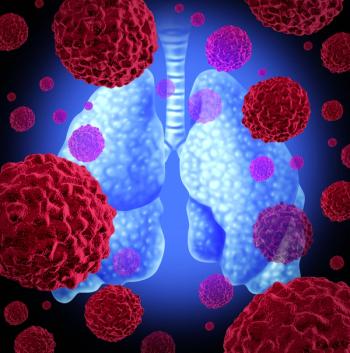
PCI Reduces Brain Metastases Without Influencing Overall Survival
The use of prophylactic cranial irradiation (PCI) reduced the incidence of symptomatic and asymptomatic brain metastases in patients with radically treated stage III NSCLC. The therapy did not, however, improve overall survival, and decreased quality of life.
The use of prophylactic cranial irradiation (PCI) reduced the incidence of symptomatic and asymptomatic brain metastases in patients with radically treated stage III non–small-cell lung cancer (NSCLC), according to a phase III trial. The therapy did not, however, improve overall survival, and decreased quality of life.
“PCI has been shown to reduce the incidence of brain metastases in patients with NSCLC to the same extent as in limited disease small-cell lung cancer,” said Harry J.M. Groen, MD, PhD, of the University Medical Center Groningen in the Netherlands. “However, the exact value of PCI in stage III [NSCLC patients] treated with contemporary chemoradiation schedules with or without surgery remains unsettled.”
Groen presented (abstract
At 2 years, treatment with PCI was successful with regard to brain metastases. Seven patients in the PCI group had any brain metastases at 2 years (8.1%) compared with 26 patients in the observation group (29.7%; P = .0004). Four of those seven had metastases and neurological symptoms (4.6%), compared with 28.4% in the observation patients (P < .001). Thirty-one PCI patients had neurological symptoms without the presence of brain metastases (36%), compared with 10 patients (11.3%) in the observation group (P = .0001).
PCI also increased the time to symptomatic brain metastases; the median time was not reached in either arm of the trial, but the hazard ratio (HR) for this measure was 0.25 (95% CI, 0.10–0.61; P = .001). This was also true for brain metastases regardless of symptoms, with an HR of 0.26 (95% CI, 0.11–0.60). The time to development of any neurological symptoms was not different between the groups.
In spite of the difference in brain metastasis rate, the overall survival (OS) between the groups was similar. The median OS was 24.2 months with PCI and 21.9 months without it (P = .52). Furthermore, the global quality of life at 3 months, as assessed by the EORCT QCQ instrument, was worse with PCI than with observation (P = .02).
“PCI works-it significantly decreases the proportion of patients developing symptomatic brain metastases,” Groen said.
But Suresh Senan, PhD, MRCP, of the VU University Medical Center in Amsterdam, the Discussant for the session, said more details on this therapy are still needed. “Should patients be offered PCI after curative treatment? No, I don’t think so, not at this time.”
Newsletter
Stay up to date on recent advances in the multidisciplinary approach to cancer.
































































































